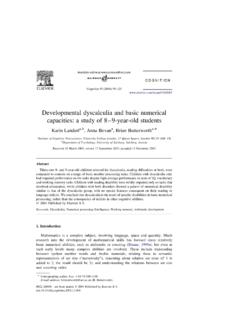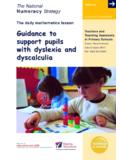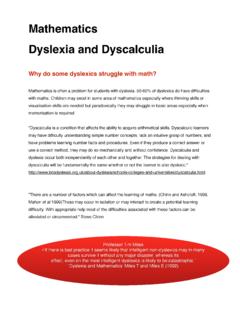Transcription of BETTER MATHS FOR A BETTER FUTURE - …
1 BETTER MATHS FOR A BETTER FUTUREAn introduction to teaching GCSE Mathematics (8300) to post-16 resit students2 WelcomeThis guide will provide you with everything you need to know about using AQA s GCSE MATHS to teach post-16 students resitting the qualification. Plus, we have dedicated resources designed to help you prepare to teach our new 9-1 MATHS GCSE specification to students studying for their resit over one year. To find out more about post-16 resits, please MATHSFOR A BETTER FUTURE16+GCSE MATHS3 From 2017 students aged 16 to 19 who wish to continue into Further Education (FE), but who received a grade 3 (including grade D or below in the June 2017 resit of the outgoing MATHS specification), must resit the GCSE.
2 Those who received 1-2 (including E or below) can choose an approved stepping stone qualification, such as Functional Skills Mathematics Level 1 (4367) or Level 2 (4368). This is necessary in order to secure funding for their chosen FE course. Students starting studying for their GCSE MATHS resit from September 2017 may have previously studied the outgoing GCSE Mathematics (Linear) B (4365) qualification or the new GCSE Mathematics (8300) SNAPSHOT RESIT OPPORTUNITIES FOR THE NEW SPECIFICATIONS We know that many of you are already teaching our new qualifications. The content and the assessment objectives for the new specification are the same for all exam boards, so the key difference between the boards is how the content and skills are tested, and the resources and support we inclusion of more challenging content Students will be tested on much more than before at both Foundation and Higher regulation Ofqual, the exams regulator, has taken steps to ensure that not only will results be comparable across all exam boards, but that all exams will cover the content and assessment objectives new progress measure Since progress and attainment for all will become the new focus.
3 The once iconic C grade will no longer be the yardstick by which students are new grading system Students will be graded from 9 1 rather than A* to G, with 9 as the highest grade. Under the new system, a grade 4 will be considered a standard pass . Students not achieving this level will be required to continue studying MATHS OF CHANGES The changes above affect all exam boards, not just a BETTER futureAt AQA we work in partnership with teachers to offer a range of MATHS develop specifications that: engage and inspire students encourage students to realise their full potential are easy to teachers choose AQA because our papers are clearer, BETTER structured and well-balanced.
4 They offer different levels of access and demand for different ability levels, providing the best opportunity for students to demonstrate their knowledge and understanding of mathematics, supporting them to make sure they achieve the results they deserve. We ve designed our new GCSE Mathematics (8300) specification to assess students skills in MATHS at all levels, providing questions that are accessible to all. Creating an assessment journeyWe ve designed our exam papers to take your students on an assessment journey. This is designed to build confidence in your students at the start of the assessment with more familiar and accessible questions making the experience a more comfortable and engaging ve also looked at the structure of our papers to BETTER support a wide range of student of GCSE resources and dedicated post-16 resources We re here to support you with the challenges ahead, so we ve created a range of GCSE resources to support the new GCSE MATHS specification and also dedicated post-16 resources that will enable you to get to know your students quickly.
5 See their skills gaps and prepare them to resit their MATHS GCSE at the right CHOOSE AQA FOR YOUR GCSE MATHS RESIT STUDENTS6 THE NEW SPECIFICATION AT A GLANCE We share your love of MATHS and your commitment to teaching and learning, so our team of exam developers listened to feedback, tested questions with students and teachers and delivered our best GCSE MATHS package yet. Here, we highlight some of the things that we think will support you and your post-16 GCSE MATHS resit Word count We ve cut the word count in our questions, used clearer language and layout to ensure students understand precisely what is being asked. 2 Assessment objectives All exam boards have to test problem solving and reasoning.
6 We embrace this because they are at the heart of what this subject is about. We have long experience in designing questions that allow us to test the objectives but are not overlong or over contextual and are accessible to students. In all our questions we want to assess what is important for mathematics and not have students confused by context or language or unnecessarily tricky Gradual challenge Consequently, students are challenged gradually as they progress, easing them into the examination and settling their New resources We re here to support you with the challenges ahead, so we ve created a range of resources and dedicated post-16 resources which are designed to help you reinforce and develop GCSE MATHS skills.
7 5 Progressive assessment We want to give students the best chance of displaying their MATHS ability while also meeting Ofqual s requirements. We know the difficulty of a question involves not just content but also context, level of reasoning and degree of problem solving. For each question in every paper, our experienced team have balanced all these elements to ensure the challenge is realistic and achievable for your students resitting their GCSE MATHS exam over one Free support We offer free support, including a comprehensive teaching guidance, assessment and teaching resources, and face-to-face support through MATHS advocates and the MATHS curriculum team. 7 WHAT S DIFFERENT ABOUT OUR NEW GCSE MATHS SPECIFICATIONE xtra contentStudents will need to learn and be tested on additional content, especially at Foundation level.
8 There is a significant shift of content from Higher to Foundation tier (for example, simultaneous equations and right-angled triangle trigonometry) Some content is new to both tiers (such as Venn diagrams and their use, knowledge of values of sine, cosine and tangent of key angles) Some content is new to the Higher tier only (including iteration, finding inverse and composite functions) Some content will no longer be tested (like stem-and-leaf diagrams) Structure of our papersFeedback from teachers has always been that shorter exams lead to BETTER performance. So our new exam employs a simple, three-paper structure that incorporates the word count, layout and accessibility improvements.
9 Students will be assessed over a 4 hours 30 minutes period, split equally across three shorter papers, giving them time to express their true abilities and achieve their best possible grade. Our new specification includes: Only one non-calculator paper Three shorter papers rather than two long ones (4 hours 30 minutes is the minimum total assessment time for all GCSE MATHS exams)Students will be required to answer all questions on all 1: non-calculatorContent from any part of the specification may be assessedEach paper: 1 hour 30 minutes written exam 80 marks of GCSEP aper 2: calculatorPaper 3: calculator8 New Assessment ObjectivesThe Department for Education (DfE) has changed the Assessment Objectives (AO) for GCSE MATHS .
10 The new GCSE has a greater focus on both Problem Solving (AO3) and Reasoning (AO2). They are now far more detailed to ensure a common approach across all exam boards. AO1 Still generally similar to the old specification, AO1 is now split into three strands. It also now includes routine multi-step questions, which were previously often designated as objective is now very different and has been split into five separate strands. The old AO2 emphasised students selecting (for themselves) what mathematical methods to use in a range of contexts. Now, the focus is on reasoning, justification, interpreting and both the old and new specifications this is about problem solving.















